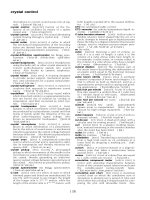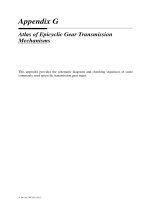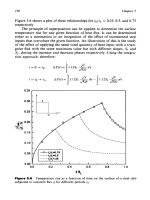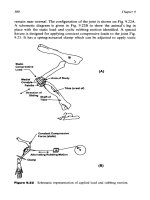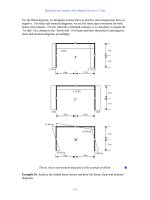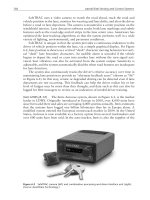ARNOLD, K. (1999). Design of Gas-Handling Systems and Facilities (2nd ed.) Episode 1 Part 7 ppsx
Bạn đang xem bản rút gọn của tài liệu. Xem và tải ngay bản đầy đủ của tài liệu tại đây (1.32 MB, 25 trang )
136
Design
of
GAS-HANDLING
Systems
and
Facilities
with
the
liquid
is
known,
the
composition
of the
feed
to
this
tray
is
also
known. This
is the
composition
of the
liquid falling
from
Tray
1.
5.
Calculate
the
temperature
of
Tray
1.
From
an
enthalpy balance,
the
temperature
of the
liquid
falling
from
Tray
1,
and
thus
the
tempera-
ture
of the
flash
on
Tray
1,
can.be calculated.
The
composition
is
known,
the
enthalpy
can be
calculated.
Enthalpy must
be
main-
tained,
so the
enthalpy
of the
liquid
of
known composition
falling
fom
Tray
1
must equal
the sum of the
enthalpies
of the
liquid
and
gas flashing
from
it at
known
temperature.
6.
This procedure
can
then
be
carried
on up the
tower
to
Tray
N,
which
establishes
the
temperature
of the
inlet
and the gas
outlet composition.
7.
From
the
composition
of the
inlet
and gas
outlet
the
liquid
outlet,
com-
position
can be
calculated
and
compared
to
that assumed
in
step
1.
8.
The
temperature
or
number
of
trays
can
then
be
varied
until
the
cal-
culated outlet
liquid
composition equals
the
assumed
composition,
and
the
vapor pressure
of the
liquid
is
equal
to or
less than
that
assumed.
If the
vapor pressure
of the
liquid
is too
high,
the
bottoms
temperature
must
be
increased.
DISTILLATION
TOWER
WITH
REFLUX
Figure
6-5
shows
a
stabilizer with
reflux.
The
well
fluid is
heated
with
the
bottoms product
and
injected into
the
tower, below
the
top, where
the
temperature
in the
tower
is
equal
to the
temperature
of the
feed. This
minimizes
the
amount
of flashing. In the
tower,
the
action
is the
same
as
in
a
cold-feed stabilizer
or any
other distillation tower.
As the
liquid
falls
Figure
6-5.
Stabilizer
with
reflux
and
feed/bottoms
heat
exchanger.
Condensate
Stabilization
137
through
the
tower,
it
goes
from
tray
to
tray,
and
gets increasingly richer
in
the
heavy components
and
increasingly
leaner
in the
light components.
The
stabilized liquid
is
cooled
in the
heat exchanger
by the
feed stream
before
flowing to the
stock tank.
At
the top of the
tower
any
intermediate components going
out
with
the
gas are
condensed, separated, pumped back
to the
tower,
and
sprayed
down
on the top
tray. This
liquid
is
called
"reflux,"
and the
two-phase
separator that
separates
it
from
the gas is
called
a
"reflux tank"
or
"reflux
dram,"
The
reflux
performs
the
same
function
as the
cold feed
in a
cold-
feed
stabilizer.
Cold liquids strip
out the
intermediate components
from
the
gas as the gas rises.
The
heat required
at the
reboiler
depends upon
the
amount
of
cooling
done
in the
condenser.
The
colder
the
condenser,
the
purer
the
product
and
the
larger
the
percentage
of the
intermediate components that
will
be
recovered
in the
separator
and
kept
from
going
out
with
the
gas.
The
hot-
ter
the
bottoms,
the
greater
the
percentage
of
light components
will
be
boiled
out of the
bottoms
liquid
and the
lower
the
vapor pressure
of the
bottoms
liquid,
A
condensate
stabilizer with reflux will
recover
more
intermediate
components
from
the gas
than
a
cold-feed stabilizer. However,
it
requires
more
equipment
to
purchase, install,
and
operate. This additional cost
must
be
justified
by the net
benefit
of the
incremental liquid recovery;
less
the
cost
of
natural
gas
shrinkage
and
loss
of
heating value, over that
obtained
from
a
cold-feed stabilizer.
CONDENSATE
STABILIZER
DESIGN
It
can be
seen
from
the
previous description that
the
design
of
both
a
cold-feed
stabilizer
and a
stabilizer
with reflux
is a
rather complex
and
involved
procedure. Distillation computer simulations
are
available that
can
be
used
to
optimize
the
design
of any
stabilizer
if the
properties
of
the
feed stream
and
desired vapor pressure
of the
bottoms product
are
known.
Cases should
be run of
both
a
cold-feed
stabilizer
and one
with
reflux
before
a
selection
is
made. Because
of the
large number
of
calcula-
tions required,
it is not
advisable
to use
hand
calculation
techniques
to
design
a
distillation process. There
is too
much
opportunity
for
computa-
tional
error.
Normally,
the
crude
or
condensate sales contract will specify
a
maxi-
mum
Reid Vapor Pressure (RVP). This pressure
is
measured according
to
138
Design
of
GAS-HANDLING
Systems
and
Facilities
a
specific ASTM testing procedure.
A
sample
is
placed
in an
evacuated
container such that
the
ratio
of the
vapor volume
to the
liquid volume
is 4
to
1.
The
sample
is
then immersed
in a
!00°F
liquid bath.
The
absolute
pressure
then measured
is the RVP of the
mixture.
Since
a
portion
of the
liquid
was
vaporized
to the
vapor space,
the
liq-
uid
will
have lost some
of its
lighter components. This
effectively
changes
the
composition
of the
liquid
and
yields
a
slightly lower vapor
pressure than
the
true vapor pressure
of the
liquid
at
100°F.
Figure
6-6
can be
used
to
estimate true vapor pressure
at any
temperature
from
a
known
RVP.
The
inherent error between true vapor pressure
and RVP
means
that
a
stabilizer
designed
to
produce
a
bottoms liquid with
a
true vapor pressure
equal
to the
specified
RVP
will
be
conservatively designed.
The
vapor
pressures
of
various hydrocarbon components
at
100°F
are
given
in
Table
6-1.
The
bottoms temperature
of the
tower
can be
approximated
if the
desired vapor pressure
of the
liquid
is
known.
The
vapor pressure
of a
mixture
is
given
by:
where
VP =
vapor pressure
of
mixture, psia
VP
n
=
vapor pressure
of
component
n,
psia
MF
n
=
mole
fraction
of
component
n in
liquid
To
estimate
the
desired composition
of the
bottom liquid,
the
vapor
pressures
of the
different components
at
100°F
can be
assumed
to be a
measure
of the
volatility
of the
component. Thus,
if a
split
of
n~C
4
is
assumed,
the
mole fraction
of
each component
in the
liquid
can be
esti-
mated
from:
(equation
continued
on
page
140)
Condensate
Stabilization
139
Figure 6-6.
Relationship
between
Reid
vapor pressure
and
actual vapor pressure.
{From
Gas
Processors
Suppliers
Association,
Engineering
Data
Book,
9th
Edition.)
140
Design
of
GAS-HANDLING
Systems
and
Facilities
Table
6-1
Vapor
Pressure
and
Relative
Volatility
of
Various
Components
Component
C,
c>
C
3
i-C
4
n-C
4
i-C
5
n-C
5
Q"
C
7
+
CO
2
N,
H
7
S
Vapor
Pressure
At
!00°F
psia
5000
800
190
72.2
51,6
20.4
15.6
5.0
-~0.1
—
—
394
Relative
Volatility
96,9
15.5
3.68
1.40
1.00
0.40
0.30
0.10
0.00
Infinite
Infinite
7.64
(equation
continued
from
page
138)
where
F
n
=
total number
of
moles
of
component
n
in
feed
L
n
=
total number
of
moles
of
component
n in the
bottom
liquid
(fl-C
4
split)
=
assumed moles
of
component
n-C
4
in
bottom liquid
divided
by
moles
of
n-C
4
in
feed
RV
n
=
relative volatility
of
component
n
from
Table
6-1
To
determine
the
compositon
of the
bottom
liquid,
assume
a
split
of n-
C
4
and
compute
MF
n
from
Equations
6-2 and
6-3.
The
vapor pressure
can
then
be
computed from Equation
6-1.
If the
vapor pressure
is
higher
than
the
desired
RVP
choose
a
lower number
for the
n-C
4
split.
If the
cal-
culated vapor pressure
is
lower than
the
desired RVP, choose
a
higher
number
for the
n~C
4
split. Iterate
until
the
calculated vapor pressure
equals
the
desired RVP.
The
bottoms temperature
can
then
be
determined
by
calculating
the
bubble
point
of the
liquid
described
by the
previous iteration
at the
cho-
sen
operating pressure
in the
tower. This
is
done
by
choosing
a
tempera-
ture,
determining equilibrium constants
from
Chapter
3,
Volume
I,
and
computing:
Condensate
Stabilization
141
If
C
is
greater than 1,0,
the
assumed temperature
is too
high.
If C is
lower
than
1.0,
the
assumed temperature
is too
low.
By
iteration
a
tem-
perature
can be
determined where
C =
1.0.
Typically,
bottoms temperatures
will
range
from
200~4QO°F
depending
on
operating
pressure,
bottoms composition,
and
vapor pressure
require-
ments.
Temperatures should
be
kept
to a
minimum
to
decrease
the
heat
requirements, limit salt build-up,
and
prevent corrosion problems,
When
stabilizer operating pressures
are
kept below
200
psig
the
reboiler temperatures will normally
be
below
300°R
A
water glycol heat-
ing
medium
can
then
be
used
to
provide
the
heat. Higher stabilizer
oper-
ating pressures require
the use of
steam-
or
hydrocarbon-based heating
mediums.
Operating
at
higher pressures, however, decreases
the flashing
of
the
feed
on
entering
the
column,
which
decreases
the
amount
of
feed
cooling
required.
In
general,
a
crude
stabilizer
should
be
designed
to
operate
between
100
and 200
psig.
TRAYS
AND
PACKING
The
number
of
actual equilibrium stages determines
the
number
of
flashes
that will occur.
The
more
stages,
the
more complete
the
split,
but
the
taller
and
more costly
the
tower. Most condensate stabilizers will nor-
mally
contain approximately
five
theoretical stages.
In a
refluxed
tower,
the
section above
the
feed
is
known
as the
rectification section, while
the
section
below
the
feed
is
known
as the
stripping section.
The
rectification
section
normally contains about
two
equilibrium stages above
the
feed,
and
the
stripping section normally contains three equilibrium stages.
Theoretical stages within
a
tower
are
provided
by
actual
stage
devices
(typically
either trays
or
packings).
The
actual diameter
and
height
of the
tower
can be
derived
using manufacturer's data
for the
particular device.
The
height
of the
tower
is a
function
of the
number
of
theoretical stages
and
of the
efficiency
of the
actual stages.
The
diameter
of the
tower
is a
function
of the
hydraulic capacity
of the
actual stages.
frays
For
most trays, liquid
flows
across
an
"active
area"
of the
tray
and
then
into
a
"downcomer"
to the
next tray below, etc. Inlet
and/or
outlet
weirs
control
the
liquid distribution across
the
tray. Vapor
flows up the
tower
and
passes through
the
tray active area,
bubbling
up
through (and
thus
contacting)
the
liquid
flowing
across
the
tray.
The
vapor distribution
142
Design
of
GAS-HANDLING
Systems
and
Facilities
is
controlled
by (1)
perforations
in the
tray deck (sieve trays),
(2)
bubble
caps
(bubble
cap
trays),
or (3)
valves
(valve
trays),
Trays
operate within
a
hydraulic
envelope.
At
excessively high vapor
rates, liquid
is
carried upward from
one
tray
to the
next (essentially back-
mixing
the
liquid phase
in the
tower).
For
valve trays
and
sieve trays,
a
capacity
limit
can be
reached
at low
vapor rates when liquid falls through
the
tray floor rather than being forced across
the
active area into
the
downcomers.
Because
the
liquid
does
not
flow
across
the
trays,
it
misses
contact with
the
vapor,
and the
separation efficiency drops dramatically.
Trays
are
generally divided into
four
categories:
(1)
sieve trays,
(2)
valve
trays,
(3)
bubble
cap
trays,
and (4)
high
capacity/high
efficiency
trays.
Sieve Trays
Sieve trays
are the
least expensive tray option.
In
sieve trays, vapor
flowing
up
through
the
tower contacts
the
liquid
by
passing through
small
perforations
in the
tray
floor
(Figure 6-7b). Sieve trays rely
on
vapor velocity
to
exclude liquid
from
falling through
the
perforations
in
the
tray
floor. If the
vapor
velocity
is
much lower than
design,
liquid
will
begin
to flow
through
the
perforations rather than into
the
downcomer.
This condition
is
known
as
weeping. Where weeping
is
severe,
the
equi-
librium
efficiency will
be
very
low.
For
this
reason, sieve trays
have
a
very
small turndown ratio.
Valve
Trays
Valve
trays
are
essentially modified sieve trays. Like sieve trays, holes
are
punched
in the
tray
floor.
However, these holes
are
much larger than
those
in
sieve
trays. Each
of
these
holes
is
fitted with
a
device
called
a
"valve."
Vapor
flowing up
through
the
tower contacts
the
liquid
by
pass-
ing
through valves
in the
tray
floor
(Figure
6-1
c).
Valves
can be
fixed
or
moving.
Fixed valves
are
permanently open
and
operate
as
deflector
plates
for the
vapor coming
up
through
the
holes
in the
tray
floor. For
moving valves, vapor passing through
the
tray
floor
lifts
the
valves
and
contacts
the
liquid. Moving valves come
in a
variety
of
designs,
depend-
ing on the
manufacturer
and the
application.
At low
vapor rates, valves
will
close,
helping
to
keep
liquid from falling through
the
holes
in the
deck.
At
sufficiently
low
vapor rates,
a
valve tray will begin
to
weep.
That
is,
some liquid will leak through
the
valves
rather
than flowing
to
Condensate
Stabilization
143
the
tray downcomers.
At
very
low
vapor rates,
it is
possible that
all the
liquid
will fall through
the
valves
and no
liquid will reach
the
downcom-
ers.
This
severe weeping
is
known
as
"dumping."
At
this point,
the
effi-
ciency
of the
tray
is
nearly zero.
Bubble
Cap
Trays
In
bubble
cap
trays, vapor
flowing up
through
the
tower contacts
the
liquid
by
passing through bubble caps (Figure 6-7a). Each bubble
cap
assembly consists
of a riser and a
cap.
The
vapor
rising
through
the
col-
umn
passes
up
through
the riser in the
tray
floor and
then
is
turned down-
ward
to
bubble into
the
liquid surrounding
the
cap. Because
of
their
design, bubble
cap
trays cannot weep. However bubble
cap
trays
are
also
more expensive
and
have
a
lower
capacity/higher
pressure
drop than
valve
trays
or
sieve trays.
Figure
6-7.
Vapor
flow
through
trays,
144
Design
of
GAS-HANDLING
Systems
and
Facilities
High
Capacity/High
Efficiency
Trays
High
capacity/high
efficiency trays have valves
or
sieve holes
or
both.
They
typically achieve higher efficiencies
and
capacities
by
taking
advantage
of the
active area under
the
downcomer.
At
this time, each
of
the
major vendors
has its own
version
of
these trays,
and the
designs
are
proprietary.
Bubble
Cap
Trays
vs.
Valve
Trays
At
low
vapor rates, valve trays will weep. Bubble
cap
trays cannot
weep (unless they
are
damaged).
For
this reason,
it is
generally assumed
that
bubble
cap
trays have nearly
an
infinite
turndown ratio. This
is
true
in
absorption
processes
(e.g.,
glycol dehydration),
in
which
it is
more
important
to
contact
the
vapor with liquid than
the
liquid with vapor,
However,
this
is not
true
of
distillation processes (e.g., stabilization),
in
which
it is
more important
to
contact
the
liquid with
the
vapor.
As
vapor rates decrease,
the
tray activity also decreases. There eventual-
ly
comes
a
point
at
which some
of the
active devices (valves
or
bubble
caps)
become inactive. Liquid passing
these
inactive devices gets very lit-
tle
contact with vapor.
At
very
low
vapor rates,
the
vapor activity will con-
centrate
only
in
certain sections
of the
tray (or,
in the
limit,
one
bubble
cap
or
one
valve).
At
this point,
it is
possible that liquid
may flow
across
the
entire
active area without ever contacting
a
significant amount
of
vapor.
This
will
result
in
very
low
tray efficiencies
for a
distillation process. Noth-
ing
can be
done with
a
bubble
cap
tray
to
compensate
for
this.
However,
a
valve tray
can be
designed with heavy valves
and
light
valves.
At
high vapor rates,
all the
valves will
be
open.
As the
vapor rate
decreases,
the
valves will begin
to
close. With light
and
heavy valves
on
the
tray,
the
heavy valves will close
first,
and
some
or all of the
light
valves will remain
open.
If the
light valves
are
properly
distributed
over
the
active area, even though
the
tray activity
is
diminished
at low
vapor
rates, what activity remains will
be
distributed across
the
tray.
All
liquid
flowing
across
the
tray will contact some vapor,
and
mass transfer
will
continue.
Of
course, even with weighted valves,
if the
vapor rate
is
reduced enough,
the
tray
will
weep
and
eventually become inoperable.
However,
with
a
properly designed valve tray this point
may be
reached
after
the
loss
in
efficiency
of a
comparable bubble
cap
tray.
So, in
distil-
lation
applications, valve trays
can
have
a
greater vapor turndown ratio
than
bubble
cap
trays.
Condensate
Stabilization
145
Tray
Efficiency
and
Tower
Height
In
condensate
stabilizers, trays generally have
70%
equilibrium stage
efficiency.
That
is,
1.4
actual
trays
are
required
to
provide
one
theoretical
stage.
The
spacing between trays
is a
function
of the
spray height
and the
downcomer
backup (the height
of
clear
liquid
established
in the
down-
corner).
The
tray spacing will typically range
from
20 to 30 in.
(with
24
in.
being
the
most common), depending
on the
specific design
and the
internal
vapor
and
liquid
traffic.
The
tray spacing
may
increase
at
higher
operating pressures (greater than
165
psia) because
of the
difficulty
in
disengaging vapor
from
liquid
on
both
the
active areas
and in the
down-
comers,
Packing
Packing typically
comes
in two
types: random
and
structured.
Liquid
distribution
in a
packed
bed is a
function
of the
internal
vapor/liquid
traffic,
the
type
of
packing employed,
and the
quality
of the
liquid
distributors mounted above
the
packed bed. Vapor distribution
is
controlled
by the
internal
vapor/liquid
traffic,
by the
type
of
packing
employed,
and by the
quality
of the
vapor distributors located below
the
packed beds.
Packing material
can be
plastic, metal,
or
ceramic. Packing
efficien-
cies
can be
expressed
as
HETP (height equivalent
to a
theoretical plate),
Random
Packing
A bed of
random packing typically consists
of a bed
support (typically
a
gas
injection support plate) upon which
pieces
of
packing material
are
randomly arranged (they
are
usually poured
or
dumped onto this support
plate).
Bed
limiters,
or
hold-downs,
are
sometimes
set
above random
beds
to
prevent
the
pieces
of
packing from migrating
or
entraining
upward.
Random packing comes
in a
variety
of
shapes
and
sizes.
For a
given
shape (design)
of
packing, small sizes have higher efficiencies
and
lower
capacities
than
large
sizes.
Figure
6-8
shows
a
variety
of
random packing designs.
An
early
design
is
known
as a
Raschig
ring.
Raschig rings
are
short
sections
of
tubing
and are
low-capacity, low-efficiency, high-pressure drop devices.
Today's industry standard
is the
slotted metal (Pall) ring.
A
packed
bed
made
of
1-in.
slotted metal rings will have
a
higher mass transfer
effi-
ciency
and a
higher capacity than
will
a bed of
1-in. Raschig
rings. The
146
Design
of
GAS-HANDLING
Systems
and
Facilities
Figure
6-8.
Various
types
of
packing.
HETP
for a
2-in,
slotted metal
ring in a
condensate stabilizer
is
about
36
in.
This
is
slightly more than
a
typical tray design, which would require
34
in.
(1.4
trays
x
24-in.
tray spacing)
for one
theoretical plate
or
stage.
Structured
Packing
A bed of
structured packing consists
of a bed
support upon which
ele-
ments
of
structured packing
are
placed. Beds
of
structured packing
typi-
cally have lower
pressure
drops than beds
of
random packing
of
compa-
rable mass transfer efficiency. Structured packing elements
are
composed
of
grids (metal
or
plastic)
or
woven mesh
(metal
or
plastic)
or of
thin
ver-
tical
crimped sheets (metal, plastic,
or
ceramic) stacked parallel
to
each
other.
Figure
6-9
shows examples
of the
vertical crimped sheet
style
of
structured
packing.
Condensate
Stabilization
147
Figure
6-9.
Structured
packing
can
offer
better
mass
transfer
than
trays.
(Courtesy
of
Koch
Engineering
Co.,
Inc.]
The
grid types
of
structured packing have very high
capacities
and
very
low
efficiencies,
and are
typically used
for
heat
transfer
or for
vapor scrub-
bing.
The
wire mesh
and the
crimped sheet types
of
structured packing typ-
ically have lower capacities
and
higher efficiencies than
the
grid type.
148
Design
of
GAS-HANDLING
Systems
and
Facilities
Trays
or
Packing
There
is no
umbrella answer.
The
choice
is
dictated
by
project scope
(new
tower
or
retrofit), current economics, operating pressures, anticipat-
ed
operating flexibility,
and
physical
properties.
'Distillation
Service
For
distillation services,
as in
condensate
stabilization,
tray
design
is
well
understood,
and
many
engineers
are
more comfortable with trays
than
with
packing.
In the
past,
bubble
cap
trays were
the
standard. How-
ever,
they
are not
commonly
used
in
this service anymore. Sieve trays
are
inexpensive
but
offer
a
very narrow operating range when compared
with
valve
trays.
Although
valve trays
offer
a
wider operating range than sieve
trays,
they have moving parts
and so may
require more maintenance.
High
capacity/high
efficiency trays
can be
more expensive than standard
valve
trays. However, high capacity/high efficiency trays require smaller
diameter towers,
so
they
can
offer
significant savings
in the
overall cost
of
the
distillation tower.
The
high
capacity/high
efficiency
tray
can
also
be
an
ideal candidate
for
tower retrofits
in
which increased
throughputs
are
required
for
existing towers.
Random packing
has
traditionally been used
in
small diameter (<20
in.)
towers. This
is
because
it is
easier
and
less
expensive
to
pack these
small
diameter towers. However, random packed beds
are
prone
to
chan-
neling
and
have poor turndown characteristics when compared
with
trays.
For
these reasons, trays were preferred
for
tower diameters greater
than
20 in. In
recent years
an
improved understanding
of the
impact
of
high pressure
on
packing performance
has
been
gained. Improved vapor
and
liquid distributor
designs
and
modified
bed
heights have made
the
application
of
packing
to
large-diameter, high-pressure distillation towers
more
common.
A
properly designed packed
bed
system (packing, liquid
distributors, vapor distributors)
can be an
excellent choice
for
debottle-
necking
existing
distillation towers.
Stripping
Service
For
stripping service,
as in a
glycol
or
amine
contactor (see Chapters
7
and
8),
bubble
cap
trays
are the
most common.
In
recent years, there
has
been
a
growing movement toward crimped sheet structured packing.
Improved
vapor
and
liquid
distributor design
in
conjunction with
struc-
Condensate
Stabilization
149
tured
packing
can
lead
to
smaller-diameter
and
shorter stripping towers
than
can be
obtained
with
trays.
CONDENSATE
STABILIZER
AS
A GAS
PROCESSING
PLANT
A
gas-processing plant,
as
described
in
Chapter
9, is
designed
to
recover ethane, propane, butane,
and
other natural
gas
liquids
from
the
gas
stream.
A
condensate stabilizer also recovers some portion
of
these
liquids.
The
colder
the
temperature
of the gas
leaving
the
overhead
con-
denser
in a
reflux
stabilizer,
or the
colder
the
feed stream
in a
cold-feed
stabilizer,
and the
higher
the
pressure
in the
tower,
the
greater
the
recov-
ery
of
these components
as
liquids. Indeed,
any
stabilization
process
that
leads
to
recovery
of
more molecules
in the
final
liquid product
is
remov-
ing
those molecules
from
the gas
stream.
In
this sense,
a
stabilizer
may
be
considered
as a
simple
form
of a
gas-processing plant.
It
is
difficult
to
determine
the
point
at
which
a
condensate stabilizer
becomes
a gas
plant. Typically,
if the
liquid product
is
sold
as a
conden-
sate,
the
device would
be
considered
a
condensate stabilizer.
If the
prod-
uct
is
sold
as a
mixed natural
gas
liquid stream (NGL)
or is
fractionated
into
its
various components,
the
same process would
be
considered
a gas
plant.
The
least volatile
NGL
stream
has an RVP
between
10 and
14
and
has
sufficient
light hydrocarbons
such
that
25% of the
total volume
is
vaporized
at
140°F.
LTX
UNIT
AS A
CONDENSATE STABILIZER
It
should
be
clear
from
the
description
of LTX
units
in
Chapter
5
that
the
lower pressure separator
in an LTX
unit
is a
simple
form
of
cold-feed
condensate stabilizer.
In the
cold, upper portion
of the
separator some
of
the
intermediate hydrocarbon components condense.
In the
hot,
lower
portion
some
of the
lighter components
flash.
An
LTX
unit
is not a
very
efficient
stabilizer because
the
absence
of
trays
or
packing keeps
the two
phases
from
approaching equilibrium
at
the
various temperatures that exist
in the
vessel.
In
addition,
it is
difficult
to
control
the
process. Typically,
for a
100-psi
to
200-psi
operating pres-
sure,
a
300°F
to
400°F
bottoms temperature
is
required
to
stabilize com-
pletely
the
condensate.
The
heating coil
in an LTX
separator
is
more
like-
150
Design
of
GAS-HANDLING
Systems
and
Facilities
ly
to be in the
range
of
125°F
to
175°F,
and
thus
complete
stabilization
will
not
occur even
if the flash
were capable
of
reaching equilibrium.
There
may be
some additional recovery
from
an LTX
unit than
would
be
realized
from
a
straight two-stage
flash
separation
process,
but
this
increment
is
normally small
and may not
justify
the
increased
equipment
cost
and
operating complexity associated with
an LTX
unit.
CHAPTER
7
Acid
Gas
Treating
*
In
addition
to
heavy hydrocarbons
and
water vapor, natural
gas
often
contains other contaminants that
may
have
to be
removed. Carbon diox-
ide
(CO2), hydrogen
sulfide
(H
2
S),
and
other
sulfur
compounds such
as
mercaptans
are
compounds that
may
require complete
or
partial removal
for
acceptance
by a gas
purchaser. These compounds
are
known
as
"acid
gases."
H
2
S
combined with water forms
a
weak
form
of
sulfuric
acid,
while
CO
2
and
water forms carbonic acid, thus
the
term
"acid
gas."
Natural
gas
with
H
2
S
or
other
sulfur
compounds present
is
called
"sour
gas," while
gas
with only
CO
2
is
called "sweet." Both
H
2
S
and
CO
2
are
undesirable,
as
they cause corrosion
and
reduce
the
heating value
and
thus
the
sales
value
of the
gas.
In
addition,
H
2
S
may be
lethal
in
very
small
quantities. Table
7-1
shows physiological
effects
of
H
2
S
concentra-
tions
in
air.
At
0.13
ppm
by
volume,
H
2
S
can be
sensed
by
smell.
At 4.6 ppm the
smell
is
quite noticeable.
As the
concentration increases beyond
200
ppm,
the
sense
of
smell fatigues,
and the gas can no
longer
be
detected
by
odor.
Thus,
H
2
S
cannot always
be
detected
by
smell. Even
if
H
2
S
cannot
be
smelled,
it is
possible that there
is
sufficient
H
2
S
present
to be
life
threat-
*Reviewed
for the
1999 edition
by K. S.
Chiou
of
Paragon Engineering Services, Inc.
151
152
Design
of
GAS-HANDLING
Systems
and
Facilities
Table
7-1
Physiological
Effects
of
H
2
S
Concentrations
in Air
Concentrations
in Air
Percent
Parts
per
Grains
by
Million
per
Volume
by
Volume
lOOscf*
0.00013
0.13
0.008
0,001
10
0.63
0,005
50
3.15
0.01
100
6.30
0.02
200
12.59
0.05
500
31.49
0.07
700
44.08
0.10+
1000+
62.98
Milligrams
per
m
3
*
0.18
14.41
72.07
144.14
288.06
720.49
1008.55
1440.98+
Physiological
Effects
Obvious
and
unpleasant odor
generally
perceptible
at
0.13
ppm
and
quite noticeable
at 4.6
ppm.
As the
concentration increases,
the
sense
of
smell fatigues
and the gas
can
no
longer
be
detected
by
odor.
Acceptable ceiling concentration
permitted
by
federal
OSHA
standards.
Acceptable maximum peak above
the
OSHA acceptable
ceiling
concentrations permitted once
for
10
minutes
per
8-hour
shift,
if no
other measurable exposure occurs.
Coughing,
eye
irritation, loss
of
sense
of
smell
after
3 to
15
minutes.
Altered respiration, pain
in
eyes,
and
drowsiness
after
1
5
to
30
minutes, followed
by
throat
irritation after
one
hour. Prolonged
exposure results
in a
gradual
increase
in the
severity
of
these
symptoms.
Kills
sense
of
smell rapidly, burns
eyes
and
throat.
Dizziness,
loss
of
sense
of
reasoning
and
balance. Breathing
problems
in a few
minutes.
Victims
need prompt artificial
resuscitation.
Unconscious quickly. Breathing
will
stop
and
deaths will result
if
not
rescued promptly. Artificial
resuscitation
is
needed.
Unconsciousness
at
once.
Permanent brain damage
or
death
may
result
unless rescued
promptly
and
given
artificial
resuscitation.
*Based
on 1%
hydrogen
sulfide
=
629.77
gr/100
scfat
14.696
psia
and
59°F,
or
101,325
kPa
and
75°C.
Acid
Gas
Treating
1S3
ening.
At 500
ppm,
H
2
S
can no
longer
be
smelled,
but
breathing
problems
and
then
death
can be
expected
within
minutes.
At
concentrations above
700 to
1,000 ppm, death
can be
immediate
and
without
warning.
General-
ly,
a
concentration
of 100 ppm
H
2
S
or
more
in a
process stream
is
cause
for
concern
and the
taking
of
proper
operating precautions.
Gas
sales contracts
for
natural gases will limit
the
concentration
of
acid
compounds.
In the
United
States,
typically,
gas
sales contracts
will
permit
up
to 2 to 3%
carbon dioxide
and
1
A
grain
per
100
scf
(approximately
4
ppm)
of
hydrogen
sulfide.
The
actual requirement
for any
sales
contract
may
vary, depending upon negotiations between seller
and
purchaser.
Next
to
sales contract specifications, corrosion protection ranks high-
est
among
the
reasons
for the
removal
of
acid gases.
The
partial
pressure
of
the
acid gases
may be
used
as a
measure
to
determine whether treat-
ment
is
required.
The
partial pressure
of a gas is
defined
as the
total pres-
sure
of the
system times
the
mole
% of the
gaseous component. Where
CO
2
is
present with free water,
a
partial pressure
of 30
psia
or
greater
would
indicate that
CO
2
corrosion should
be
expected.
If
CO
2
is not
removed, inhibition
and
special metallurgy
may be
required. Below
15
psia,
CO
2
corrosion
is not
normally
a
problem,
although
inhibition
may
be
required.
H
2
S
may
cause hydrogen
embrittlement
in
certain metals. Figures
7-1
and
7-2
show
the
H
2
S
concentration
at
which
the
National Association
of
Corrosion
Engineers (NACE) recommends special metallurgy
to
guard
against
H
2
S
corrosion.
In
the
sulfide stress cracking region, appropriate metallurgy
is
required
in
line piping, pressure vessels, etc. There
is a
listing
of
accept-
able steels
in the
NACE standard.
Steels
with
a
hardness
of
less
than
22
Rockwell
C
hardness should
be
used
in
areas where
sulfide-stress
crack-
ing is a
problem.
The
concentration
of
H
2
S
required
for
sulfide-stress cracking
in a
mul-
tiphase
gas/liquid
system (Figure 7-2)
is
somewhat
higher
than
in
pure
gas
streams (Figure
7-1).
The
liquid acts
as an
inhibitor.
This chapter discusses
the
different
processes
that
are
commonly used
in
field
gas
treating
of
acid gases
and
presents
a
method that
can be
used
to
select
from
among
the
various processes. Design procedures
for
deter-
mining
critical sizing parameters
for
iron sponge
and
amine systems
are
presented,
as
these
are the
most common field
gas
treating processes cur-
rently
employed
and
they
are not
proprietary
in
nature.
(text
continued
on
page
.156)
Figure
7-1,
H
2
S
concentration
required
for
sulfide-sfress
cracking
in a
pure
gas
system.
(Courtesy
of
National
Association
t
Corrosion
Engineers,}
Figure 7-2,
H
2
S
concentration
required
for
suifide-siress
cracking
in a
multiphase
gas/liquid
system.
(Courtesy
of
Notional
Association
of
Corrosion Engineers.)
156
Design
of
GAS-HANDLING
Systems
and
Facilities
(text
continued from page
153)
GAS
SWEETENING
PROCESSES
Numerous
processes have been developed
for gas
sweetening based
on
a
variety
of
chemical
and
physical principles.
These
processes
can be
cat-
egorized
by the
principles used
in the
process
to
separate
the
acid
gas and
the
natural
gases
as
follows:
Process
Licensor
1.
Solid
bed
absorption
Iron
Sponge
SulfaTreat®
The
SulfaTreat Company
Zinc
Oxide
Molecular
Sieves Union Carbide Corporation
2.
Chemical solvents
Monoethanol
amine
(MEA)
Diethanol
amine
(DBA)
Methyldiethanol
amine (MDEA)
Diglycol
amine
(DG
A)
Diisopropanol amine
(DIPA)
Hot
potassium carbonate
Proprietary
carbonate systems
3.
Physical solvents
Fluor
Flexsorb®
Fluor Daniel
Corporation
Shell
Sulfmol®
Selexol®
Norton
Co.,
Chemical Process
Products
Rectisol®
Lurg,
Kohle
&
Mineraloltechnik
GmbH
&
Linde A.G.
4.
Direct conversion
of
H
2
S
to
sulfur
Claus
LOCAT
ARI
Technologies
Stretford
Ralph
M.
Parsons
Co.
IFP
Institute
Fran^ais
du
Petrole
Sulfa-check
Exxon Chemical
Co.
5.
Sulfide
scavenger
6.
Distillation
Amine-aldehyde
condensates
7.
Gas
permeation
Acid
Gas
Treating
157
The
list, although
not
complete, does represent
many
of the
commonly
available
commercial
processes.
New
proprietary processes
are
being
developed.
The
design engineer
is
cautioned
to
consult with vendors
and
experts
in
acid
gas
treating before
making
a
selection
for any
large
plant,
Solid
Bed
Absorption
A
fixed
bed of
solid particles
can be
used
to
remove acid gases either
through chemical
reactions
or
ionic bonding. Typically,
in
solid
bed
absorption
processes
the gas
stream must
flow
through
a
fixed
bed of
solid particles that remove
the
acid
gases
and
hold them
in the
bed.
When
the
bed is
saturated
with
acid gases,
the
vessel must
be
removed
from
ser-
vice
and the bed
regenerated
or
replaced.
Since
the bed
must
be
removed
from
service
to be
regenerated, some spare capacity must
be
provided.
There
are
three commonly used processes under this category:
the
iron
oxide
process,
the
zinc oxide process,
and the
molecular sieve process,
Iron Sponge
The
iron
sponge process uses
the
chemical reaction
of
ferric oxide
with
H
2
S
to
sweeten
gas
streams. This process
is
applied
to
gases
with
low
H
2
S
concentrations
(300 ppm)
operating
at low to
moderate pres-
sures
(50-500
psig). Carbon dioxide
is not
removed
by
this
process.
The
reaction
of
H
2
S
and
ferric oxide produces water
and
ferric
sulfide
as follows:
2Fe
2
O
3
+
6H
2
S
->
2Fe
2
S
3
+
6H
2
0
(7-1)
The
reaction requires
the
presence
of
slightly alkaline water
and a
tem-
perature
below
110°F.
If the gas
does
not
contain sufficient water vapor,
water
may
need
to be
injected into
the
inlet
gas
stream. Additionally,
bed
alkalinity
should
be
checked daily.
A pH
level
of
8-10
should
be
main-
tained
through
the
injection
of
caustic soda with
the
water.
The
ferric
oxide
is
impregnated
on
wood chips, which produces
a
solid
bed
with
a
large
ferric
oxide surface area. Several grades
of
treated wood
chips
are
available, based
on
iron oxide content.
The
most common grades
are
6.5-,
9.0-,
15.0-,
and
20-lb
iron
oxide/bushel.
The
chips
are
contained
in
a
vessel,
and
sour
gas flows
through
the bed and
reacts with
the
ferric
oxide. Figure
7-3
shows
a
typical
vessel
for the
iron sponge
process.
1
58
Design
of
GAS-HANDLING
Systems
and
Facilities
Figure
7-3.
Iron
oxide
acid
treating
unit.
The
ferric
sulfide
can be
oxidized with
air to
produce
sulfur
and
regener-
ate the
ferric oxide.
The
reaction
for
ferric
oxide regeneration
is as follows:
The
regeneration
step
must
be
performed with
great
care
as the
reac-
tion with oxygen
is
exothermic (that
is,
gives
off
heat).
Air
must
be
intro-
duced slowly
so the
heat
of
reaction
can be
dissipated.
If air is
introduced
quickly
the
heat
of
reaction
may
ignite
the
bed.
Acid
Gas
Treating
159
Some
of the
elemental
sulfur
produced
in the
regeneration step
remains
in the
bed. After several cycles this
sulfur
will cake over
the
fer-
ric
oxide,
decreasing
the
reactivity
of the
bed. Typically,
after
10
cycles
the
bed
must
be
removed
from
the
vessel
and
replaced with
a new
bed.
In
some designs
the
iron sponge
may be
operated with
continuous
regeneration
by
injecting
a
small amount
of air
into
the
sour
gas
feed.
The air
regenerates ferric sulflde while
H/>S
is
being removed
by
ferric
oxide. This
process
is not as
effective
at
regenerating
the bed as the
batch
process.
It
requires
a
higher pressure
air
stream,
and if not
properly con-
trolled
may
create
an
explosive mixture
of air and
gas.
Hydrocarbon
liquids
in the gas
tend
to
coat
the
iron sponge media,
inhibiting
the
reactions.
The use of an
adequately
designed
gas
scrubber
or
filter
separator
upstream
of the
iron sponge unit will minimize
the
amount
of
liquids that condense
on the
bed. Sometimes
the
process
can
be
arranged
so
that
the
scrubber operates
at a
lower temperature
or
higher
pressure
than
the
iron sponge
unit,
so
that there
is no
possibility
of
hydrocarbon liquids condensing
in the
iron sponge unit.
Due
to the
difficulty
of
controlling
the
regeneration step,
the
eventual
coating
of the bed
with elemental
sulfur,
the low
cost
of
iron sponge mate-
rial,
and the
possibility
of
hydrocarbon liquids coating
the
bed,
iron
sponge units
are
normally operated
in the
batch mode.
The
spent
bed is
removed
from
the
unit
and
trucked
to a
disposal site.
It is
replaced
with
a
new
bed and the
unit
put
back
in
service.
The
spent
bed
will react with
the
oxygen
in air as
shown
in
Equations
7-2 and 7-3
unless
it is
kept moist.
In
areas
where iron sponge units
are
installed, service companies exist that
can
replace iron sponge beds
and
properly dispose
of the
waste
material.
SulfaTreat®
SulfaTreat®
process
is
similar
to the
iron sponge process.
It
uses
a
patented
proprietary
mixture
of
ferric
oxide
and
triferric
oxide
to
react
with
H
2
O
to
sweeten
gas
streams.
In
SulfaTreat®
process
the
iron
oxides
are
supported
on the
surface
of an
inert, inorganic substrate forming
a
granular material, while
in the
iron sponge
process
the
ferric oxide
is
impregnated
on
wood
chips.
The
SulfaTreat® starting material
and the
spent product
are
safe
and
stable.
The
spent product
can be
recycled
or
disposed
in a
landfill.
Two
vessels arranged
in
series,
a
lead/lag
arrangement, will allow
the
SulfaTreat®
material
to be
used more
efficiently
with
no
interruption
in
unit
service
and
greater process reliability.
The
first vessel,
the
"lead"
16©
Design
of
GAS-HANDLING
Systems
and
Facilities
unit,
acts
as the
"working" unit
to
remove
all the
H
2
S
at the
beginning
of
a
treatment period with
its
outlet
H
2
S
increasing over time.
The
exit
gas
from
the
first
vessel
can go to the
second vessel,
the
"lag"
unit,
for
fur-
ther
polishing
or
bypass
the
second vessel
as
though
the first
vessel
is
operating
in a
single vessel arrangement.
The
second vessel
is to
be
placed
in
operation
as the lag
unit
to
polish
the
H
2
S
remaining
in the gas
when
the
lead unit outlet
H^S
starts
to
approach
the
specification.
Once
the
lead unit inlet
and
outlet concentrations
are
equal,
the
Sulfa-
Treat®
material
is
considered spent
or
exhausted. Then,
the gas flow is
directed
to the
second vessel, which becomes
the
lead unit.
The
spent
material
is
removed
from
the first
vessel
and the
fresh
SulfaTreat®
mater-
ial
reloaded
to be
placed into operation
as the lag
unit
without
gas flow
interruption.
Removal
of the
spent
SulfaTreat®
material
and the
reload
of
the
fresh
material could
be
conveniently scheduled using
the
change-out
"window" available without exceeding maximum outlet
H
2
S
concentra-
tions
when
operating
in
this
lead/lag
mode.
Zinc
Oxide
The
zinc oxide
process
is
similar
to the
iron sponge
process.
It
uses
a
solid
bed of
granular zinc oxide
to
react
with
the
H
2
S
to
form
water
and
zinc
sulfide:
The
rate
of
reaction
is
controlled
by the
diffusion
process,
as the
sulfide
ion
must
first
diffuse
to the
surface
of the
zinc oxide
to
react. High
tem-
perature (>250°F) increases
the
diffusion
rate
and is
normally used
to
promote
the
reaction rate.
Zinc oxide
is
usually contained
in
long, thin beds
to
lessen
the
chances
of
channeling. Pressure drop through
the
beds
is
low.
Bed
life
is a
func-
tion
of gas
H
2
S
content
and can
vary
from
6
months
to in
excess
of
10
years.
The
spent catalyst
is
discharged
by
gravity
flow and
contains
up to
20
weight percent
of
sulfur.
The
process
has
seen decreasing
use due to
increasing disposal prob-
lems
with
the
spent catalyst, which
is
classified
as a
heavy
metal
salt.
Molecular
Sieves
The
molecular sieve process uses synthetically manufactured solid
crystalline zeolite
in a dry bed to
remove
gas
impurities.
The
crystalline




